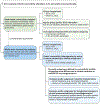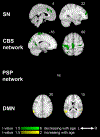Network Connectivity Alterations across the MAPT Mutation Clinical Spectrum
- PMID: 37431188
- PMCID: PMC10727479
- DOI: 10.1002/ana.26738
Network Connectivity Alterations across the MAPT Mutation Clinical Spectrum
Abstract
Objective: Microtubule-associated protein tau (MAPT) mutations cause frontotemporal lobar degeneration, and novel biomarkers are urgently needed for early disease detection. We used task-free functional magnetic resonance imaging (fMRI) mapping, a promising biomarker, to analyze network connectivity in symptomatic and presymptomatic MAPT mutation carriers.
Methods: We compared cross-sectional fMRI data between 17 symptomatic and 39 presymptomatic carriers and 81 controls with (1) seed-based analyses to examine connectivity within networks associated with the 4 most common MAPT-associated clinical syndromes (ie, salience, corticobasal syndrome, progressive supranuclear palsy syndrome, and default mode networks) and (2) whole-brain connectivity analyses. We applied K-means clustering to explore connectivity heterogeneity in presymptomatic carriers at baseline. Neuropsychological measures, plasma neurofilament light chain, and gray matter volume were compared at baseline and longitudinally between the presymptomatic subgroups defined by their baseline whole-brain connectivity profiles.
Results: Symptomatic and presymptomatic carriers had connectivity disruptions within MAPT-syndromic networks. Compared to controls, presymptomatic carriers showed regions of connectivity alterations with age. Two presymptomatic subgroups were identified by clustering analysis, exhibiting predominantly either whole-brain hypoconnectivity or hyperconnectivity at baseline. At baseline, these two presymptomatic subgroups did not differ in neuropsychological measures, although the hypoconnectivity subgroup had greater plasma neurofilament light chain levels than controls. Longitudinally, both subgroups showed visual memory decline (vs controls), yet the subgroup with baseline hypoconnectivity also had worsening verbal memory and neuropsychiatric symptoms, and extensive bilateral mesial temporal gray matter decline.
Interpretation: Network connectivity alterations arise as early as the presymptomatic phase. Future studies will determine whether presymptomatic carriers' baseline connectivity profiles predict symptomatic conversion. ANN NEUROL 2023;94:632-646.
© 2023 The Authors. Annals of Neurology published by Wiley Periodicals LLC on behalf of American Neurological Association.
Conflict of interest statement
Potential Conflicts of Interest
All authors report no conflict of interest relevant to the current study.
Figures







References
-
- Hutton M, Lendon CL, Rizzu P, et al. Association of missense and 5Ј-splice-site mutations in tau with the inherited dementia FTDP-17. Nature 1998;393(6686):702–705. - PubMed
Publication types
MeSH terms
Substances
Grants and funding
- R01 AG071756/AG/NIA NIH HHS/United States
- R01 AG075775/AG/NIA NIH HHS/United States
- R01 AG058233/AG/NIA NIH HHS/United States
- R21 NS114764/NS/NINDS NIH HHS/United States
- R01 AG038791/AG/NIA NIH HHS/United States
- R00 AG065457/AG/NIA NIH HHS/United States
- U01 NS080818/NS/NINDS NIH HHS/United States
- P30 AG062422/AG/NIA NIH HHS/United States
- P01 AG019724/AG/NIA NIH HHS/United States
- P30 AG066530/AG/NIA NIH HHS/United States
- RF1 NS050915/NS/NINDS NIH HHS/United States
- K01 AG055698/AG/NIA NIH HHS/United States
- K99 AG065457/AG/NIA NIH HHS/United States
- R01 AG062268/AG/NIA NIH HHS/United States
- U01 AG045390/AG/NIA NIH HHS/United States
- U54 NS092089/NS/NINDS NIH HHS/United States
- K24 DC015544/DC/NIDCD NIH HHS/United States
- R01 AG083799/AG/NIA NIH HHS/United States
- R25 NS098999/NS/NINDS NIH HHS/United States
- K24 AG045333/AG/NIA NIH HHS/United States
- U01 AG079850/AG/NIA NIH HHS/United States
- U01 NS100610/NS/NINDS NIH HHS/United States
- U24 AG021886/AG/NIA NIH HHS/United States
- U19 AG063911/AG/NIA NIH HHS/United States
- R01 AG052496/AG/NIA NIH HHS/United States
- RF1 NS100440/NS/NINDS NIH HHS/United States
- P01 AG066597/AG/NIA NIH HHS/United States
- K12 HD001459/HD/NICHD NIH HHS/United States
- R01 AG057234/AG/NIA NIH HHS/United States
- R01 MH120794/MH/NIMH NIH HHS/United States
- R01 NS050915/NS/NINDS NIH HHS/United States
- P30 AG066509/AG/NIA NIH HHS/United States
- P30 AG072977/AG/NIA NIH HHS/United States
- P30 AG062677/AG/NIA NIH HHS/United States

